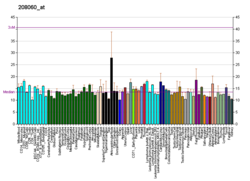PAX7
Paired box transcription factor protein From Wikipedia, the free encyclopedia
Paired box protein Pax-7 is a protein that in humans is encoded by the PAX7 gene.[5][6][7]
Function
Summarize
Perspective
Pax-7 plays a role in neural crest development and gastrulation, and it is an important factor in the expression of neural crest markers such as Slug, Sox9, Sox10 and HNK-1.[8] PAX7 is expressed in the palatal shelf of the maxilla, Meckel's cartilage, mesencephalon, nasal cavity, nasal epithelium, nasal capsule and pons.
Pax7 is a transcription factor that plays a role in myogenesis through regulation of muscle precursor cells proliferation. It can bind to DNA as an heterodimer with PAX3. Also interacts with PAXBP1; the interaction links PAX7 to a WDR5-containing histone methyltransferase complex By similarity. Interacts with DAXX too.[9]
PAX7 functions as a marker for a rare subset of spermatogonial stem cells, specifically a sub set of Asingle spermatogonia.[10] These PAX7+ spermatogonia are rare in adult testis but are much more prevalent in newborns, making up 28% of germ cells in neonate testis.[10] Unlike PAX7+ muscle satellite cells, PAX7+ spermatogonia rapidly proliferate and are not quiescent.[10][11] PAX7+ spermatogonia are able to give rise to all stages of spermatogenesis and produce motile sperm.[10] However, PAX7 is not required for spermatogenesis, as mice without PAX7+ spermatogonia show no deficits in fertility.[10]
PAX7 may also function in the recovery in spermatogenesis. Unlike other spermatogonia, PAX7+ spermatogonia are resistant to radiation and chemotherapy.[10] The surviving PAX7+ spermatogonia are able to increase in number following these therapies and differentiate into the other forms of spermatogonia that did not survive.[10] Additionally, mice lacking PAX7 had delayed recovery of spermatogenesis following exposure to busulfan when compared to control mice.[10]
Clinical significance
Pax proteins play critical roles during fetal development and cancer growth. The specific function of the paired box gene 7 is unknown but speculated to involve tumor suppression since fusion of this gene with a forkhead domain family member has been associated with alveolar rhabdomyosarcoma. Alternative splicing in this gene has produced two known products but the biological significance of the variants is unknown.[7] Animal studies show that mutant mice have malformation of maxilla and the nose.[12]
See also
References
Further reading
External links
Wikiwand - on
Seamless Wikipedia browsing. On steroids.





